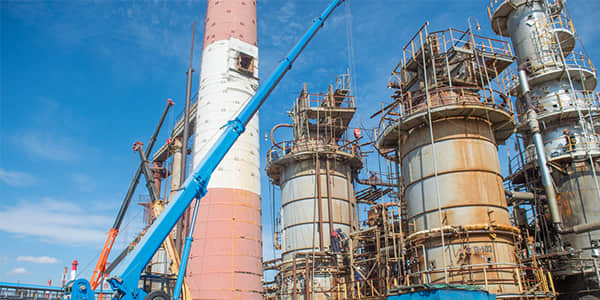Refinery Scaffolding
Refinery scaffolding is a specialized temporary structure for industrial centers, such as a refinery or a petrochemical facility. The structure of refineries may be inherently complicated and dangerous and as such, the scaffolding must be extremely safe, stable and durable, in addition to having the adaptability to the different harsh conditions of working in a refinery (hot, highly-pressurized environments and potentially corrosive). Scaffolding for refineries is not only utilized for day-to-day maintenance and inspections, but it is also also utilized in new construction or remodels to ensure safe and efficient working in high or marginalized depth conditions.
Benefits Of Scaffolding in Refinery
- Enhance Safety: Refinery scaffolding features sophisticated Engineering and design specifications to meet rigorous safety standards that minimizes workers' risks at height use - yet ensuring proper and adequate support during work operations.
- Quick Construction: Scaffolding equipment is very easy to erect and dismantle, maximizing refinery profitability by minimizing downtime during operational maintenance, or overhaul construction projects surrounding completion schedules.
- Adaptable for Complex Environment: Refinery facilities are typically complex in nature and limited in space. Scaffolding can be used as adaptable and modified agent based on site task needs to function properly within the variety of work areas.
- Saves money: Although greater costs appear upfront for refinery scaffolding, the expenses almost always pay off in worth while providing excess dollars saved down the road by eliminating liability and time used with improved work functions.
Refinery Scaffold Classification
Community charging overall solution covers all application
-
 Steel Pipe Fastener Scaffold
Steel Pipe Fastener Scaffold
With great load capacity and flexibility, the structural characteristics of the scaffold provide strong performance capability for operations in high-altitude work scenarios such as maintenance of pipelines and towers.
-
 Cup-lock Scaffold
Cup-lock Scaffold
A simple and quick-setup scaffolding structure, there is often a cup-hook scaffold used for internal equipment maintenance and limited use repair work.
-
 Frame Scaffold
Frame Scaffold
A modular design scaffold that is easily assembled and disassembled at low heights, can be used for maintence of infrastructure, and pipeline replacement inside the refinery.
Community charging overall solution covers all application
-
 Ringlock Scaffolds
Ringlock Scaffolds
Strong stability and load performance capabilities, highly utilized in refinery during the execution of construction projects involving high-altitude work, especially during dis-assembly and assemblies activities of large projects.
-
 Suspension Scaffold
Suspension Scaffold
Specifically for aerial work scenarios, typical usage in repairing equipment in the refinery during maintenance activities for the work area of towers and chimneys.
-
 Aluminum Scaffolding
Aluminum Scaffolding
Light weight and corrosion resistant, typical use in the refinery construction observation of temporary or light maintenance activities.
Case Studies Of Refinery Scaffolding Projects
In order to display more clearly the use of refinery scaffolding on actual projects, we will provide the three following examples of projects where we describe a project background, issues encountered, solutions implemented and project outcomes.
Case 1: Middle East Refinery Maintenance Project

- Site of the operation: Saudi Arabia.
- Background to the Project: The specific project in question is being undertaken at a large oil refinery in Saudi Arabia. The activity involves equipment maintenance. Equipment has sustained wear and tear due to continuous operation and high temperatures as well as high exposure to corrosive gases, and scaffolding is required to carry out the necessary maintenance and repair at heights.
Project Challenge:
- Adverse Climate Conditions: The temperature in Saudi Arabia is frequently higher than 45℃, which generates extreme demands on heat resistance and stability of scaffolding materials.
- Height Safety Risks: The equipment maintenance area is at height, and some working access is above 20 meters. The scaffolding must also have a very high load capacity while maintaining high safety.
- Time Constraints: The refinery had a very restrictive downtime schedule, and the project had to be completed in this timeframe so that to not disrupt the refinery production schedule.
Solution:
- Select a high-strength, hot-dip galvanizing steel scaffolding system with excellent resistance to high temperatures, such hot-dip galvanizing will be less likely to deform or become unstable in high temperatures.
- Due to the nature of the project's working environment being more complex than conventional builds, a multi-layered three-dimensional scaffold was designed, along with the addition of safety fencing and anti-slip devices, to keep the workers safe while working at a height.
- The project team worked closely with the refinery's operation and maintenance team to optimize the construction process, shorten the construction period through a 24-hour shift system, and ensure that each maintenance link was seamlessly connected.
Result:
Maintenance was completed 2 days earlier than scheduled. The scaffolding system was in place for the duration of the maintenance, and workers were kept safe without any additional cost associated with equipment downtime.
Case 2: African Refinery Expansion Project

- Project location: Nigeria
- Project Background: A large Refinery in Nigeria intends to expand the refinery by constructing new refinery towers and installing pipelines and relocating equipment. The range of upgrade requires a significant amount of scaffolding system support to enable the worker to work at high height.
Project Challenge:
- Complex Terrain: The refinery site is located within a coastal region with challenging terrain, some areas are unstable, adding to the difficulty of building scaffolding.
- Logistical Constraints: The refinery site is located in a remote area with limited transportation conditions, which impact the transportation of materials, and equipment arrival. Transportation resources must be used efficiently.
- Unpredictable Weather Conditions: Sudden rainstorm/ high temperatures can happen in Africa’s tropical climate, impacts to construction schedule.
Solution:
- The modular aluminum scaffolding system is a quick, lightweight, robust as well as easily assembled and disassembled system. The aluminum scaffolding effectively solved the problems associated with difficult site conditions. In addition, the aluminum alloy material has excellent corrosion resistance properties which are great for coastal environments.
- The project team developed a logistics strategy that included multiple logistical phases creating the ladder to facilitate the transportation of scaffolding material in batches to reduce transportation costs, as well as, ensuring each phase has a sufficient supply of materials on site.
- During the course of the project, temporary awnings and protective equipment were installed to address sudden rain storms and a meteorological monitoring system was used to predict the weather and adjusted for any reported changes, to account for the safety of workers during grave weather.
Summary:
Even with inclement weather and tricky ground conditions, the project team was able to complete the expansion. The scaffolding system preformed very well during this process, keeping workers safe and allowing construction to facilitate without any delays tied to inclement weather.
When Should You Replace Refinery Scaffolding?
Replacement of refinery scaffolding will usually depend on the frequency of use, environmental conditions at the refinery site, and the method of maintenance. The following are common replacement indicators:
- Physical damage or rust: The corrosive environment of the refinery means that steel scaffolding will rust or corrode, and it should be replaced immediately after visible structural damage is observed.
- Aggressive scaffold instability: After a period of time in use, scaffolding will loosen, rendering the scaffolding unsafe. If the scaffolding cannot be stabilized during maintenance, your next step of action should be scaffold replacement.
- Safety noncompliance: In situations where the scaffolding does not meet the latest safety standards, scaffolding replacement must occur as soon as possible for worker safety.
Is Inspection Necessary For Scaffolding Erected Near Refinery?
The requirements for inspection are not eliminated when working with refinery scaffolding. You will have to address multiple inspection in-place, which incorporates aspects of inspection as well as your obligations to inspect. The brief list of inspection required for scaffolding around the refinery will be:
- Pre-construction inspection - evidence that the denoted materials and component parts meet a level of safety that is referred to as 'not damaged or missing', upon construction, and the actually design options of the structure was built to use.
- Inspection(s) during use - while the scaffolding is in-use, you must conduct, to some measure, inspections of, or with a level of concern to, stability/safety of the use throughout - that is, Faby factors, and the noting/consider, Looseness/instability, for the period of 'high temperature and high pressure' that adversely affects stability of structure, or safety and stability in work.
- Post-disassembly inspection - Again, considerable review ,of component parts for inspection after dismantling the unit , can be conducted to ensure that all items are 'undamaged, preparation, and such'. Surface areas exposed for review and exposure to be determined if pre-exposed.
In conclusion
scaffolding in refineries is essential to construction, renovations, and maintenance from refineries across the world. Precise design, highly durable materials, and professional scaffolding solutions provide mechanical worker safety and the potential for improved project efficiency and quality. The project cases offered excellent information about scaffolding performance in the difficult and challenging site conditions, providing information to other projects in consideration. Refineries use scaffolding for maintenance of equipment during high temperature, high pressure, and using precautions during the execution of expansion activities in challenging terrain and weather. The examples demonstrate the greatly adaptable reliability of scaffolding, which are important for the safe operation and the efficient operation of a refinery.
FAQ
What international standards does the refinery scaffolding comply with?
- Refinery scaffolding usually needs to comply with the relevant safety standards of OSHA (US Occupational Safety and Health Administration) and ISO (International Organization for Standardization). In addition, the local building codes and industry standards of the project location must also be strictly followed.
What is the service life of refinery scaffolding?
- The service life of refinery scaffolding depends on its material, maintenance and the environment in which it is used. Steel scaffolding usually has a longer service life, especially if it is properly maintained. Aluminum scaffolding has a slightly shorter service life, but it has better corrosion resistance and is suitable for special environments such as chemical plants.
How long does it take to erect scaffolding at a refinery?
- The time it takes to erect scaffolding depends on the size and complexity of the project. Typically, smaller scaffolding can be erected in a few days, while larger projects may take weeks. A scaffolding system with a modular design can speed up the erection and shorten the construction period.
 Steel Pipe Fastener Scaffold
Steel Pipe Fastener Scaffold Cup-lock Scaffold
Cup-lock Scaffold Frame Scaffold
Frame Scaffold Ringlock Scaffolds
Ringlock Scaffolds Suspension Scaffold
Suspension Scaffold Aluminum Scaffolding
Aluminum Scaffolding
